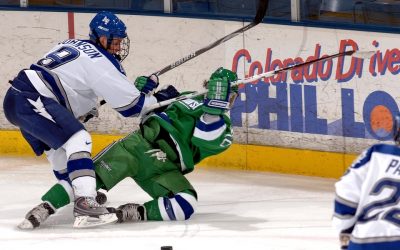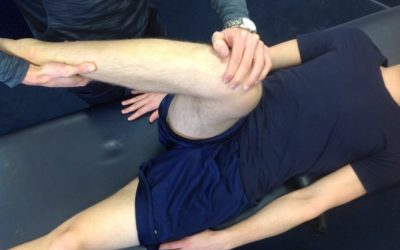The arm movement while skating is often poorly taught
Moving at a fast pace on a slippery surface in boots that rely on blades of about 3.2mm wide is a daunting task. Skating is certainly a difficult task to master and it sometimes seems too complex to teach. Many “power skaters” disagree on the desired direction of the swinging arms in a skating stride (1-8). While some believe that players should swing their arms in a front to back motion (3-6), others advocate for a side to side swinging motion (1,2,7,8). Let’s see what science has to say on this.
First, it is essential to recall Newton’s 3rd law stating that action is always equal to the reaction. In other words, it explains that the actions of two bodies upon each other are always equal and in opposite directions. This is exactly what happens when we are pushing backwards against the floor with our legs in order to move forward when we are walking with our arms and head back to counteract the forces. In short, if the movement of the arms is efficient when skating, it will increase the reaction force on the ground when pushing, thereby allowing the player to achieve greater speed.
On the one hand, coaches advocating swinging the arms from front to back while skating argue it helps generate momentum in the same way we use the arms while running for example (4) . According to them, this technique would contribute to the forward movement of the body as it appears in sprinting or walking. They even argue that moving the arms from one side to the other would cause a loss of energy, power, and balance (5). However, as we all know, skating is very different from running. The fact that the players are standing on blades on a surface with little friction brings many differences with the motion of running that we know. While field hockey players drive straight back in the same way as walking or running, little movement takes place and that’s why leg flares are made more in a frontal plane.
On the other hand, there are more arguments and scientific evidence in favor of the side-to-side swing. Indeed, this technique was found to be the most effective in the only study comparing different techniques of arm movements during the skating stride. The three techniques compared in the study were: side to side, front to back and 45 ° (2). It was observed that the side-to-side technique produces more force in the frontal plane, the plane in which the legs are mostly moving among fast skaters. In short, this transfer of force when skating forward was be associated with higher speeds (8). This is also the reason why this technique is widely used in speed skating (1).
Overall, as discussed in a previous article, outside of the few first strides at the start, the thrust should not be directed to the rear, but more to the side (1,2,7,8). The arms should be directed in the same plane of motion as the legs. While skating forward, the legs mainly move in a frontal and sagittal plane and the arms should swing the same way. On a forward start, as our legs are pushing backwards, it would possibly be preferable that the arms counterbalance this movement by rocking back to back. For the remaining skating motion, the faster the skater move, the more outbreaks are done on the side and arm movements have to adjust in the same way (1,2,7,8).
Finally, it is important to know that the effectiveness of arm movement during skating not only depends on the direction, but also on the speed and coordination of it. (8) Ultimately, the similarity between the skaters and the elite sprinters are that the rapid movement of the right arm goes in the opposite direction to that of the right leg and vice versa.
Written by Maxime Provencher, M. Physiotherapy
References :
1. Alexander, M. J. L., Hayward, J. & Taylor, C. (2010). Arm action in field hockey skating – is it being taught incorrectly? Sport Biomechanics Laboratory, University of Manitoba, copyright, 2010
2. Bracko, M. R., Fellingham, G. W., & Lyons, R. D. (1996). Glenohumeral kinematics: A comparison of three techniques during an ice hockey acceleration test. Medicine & Science in Sports & Exercise, 28(S55).
3. Glantz, R. (2010). Skating tips from our videos. Retrieved Aug/15, 2015.
4. Nauman, W. (2009). Ice hockey skating techniques. Retrieved Aug/15, 2015.
5. Rhoads, R. (2010). Field hockey skating tips – 3 great tips to improve your skating speed and power. Retrieved Aug/15, 2015.
6. Stamm, L. (2000). The arm swing. Retrieved Aug/15, 2015.
7. Bracko MR. (2004) Biomechanics powers ice hockey performance. Sports Med Biomech. 2004 Sept:47-53.
8. Hayward, J & al. Ground reaction forces produced by two different field hockey skating arm swing techniques. A Thesis submitted to the Faculty of Graduate Studies of The University of Manitoba In partial fulfillment of the requirements of the degree of MASTER OF SCIENCE Faculty of Kinesiology and Recreation Management University of Manitoba Winnipeg Copyright© 2012 by Juliene Hayward
You want to stay up to date and receive all the articles before anybody else?
Register to our newsletter.
From the same author
High ankle sprain in field hockey players: is it possible wearing skate?
High ankle sprain in field hockey players : is it possible wearing skate? Ève Physiotherapist Ankle sprains are not the first injury that comes to mind when you think about injuries in field hockey. The lateral ankle sprain, often seen in basketball and soccer is...
Field hockey and Yoga, a good combination?
Field hockey and Yoga, should we combine them? MAXIME Sport Physiotherapist The practice of yoga has been gaining popularity in North America since the beginning of the century. In 2005, there were more than 1.4 million people who practiced yoga in Canada alone. It...
What if the hip was guilty?
What if the hip was guilty? MAXIME Sport physiotherapist In previous articles, we discussed some risk factors for groin injuries and ways to prevent them. Beyond prevention, if there’s still pain in this region, it’s not always easy to return to play....


